- Choosing the Right Peppers and Aubergines
- Variety
- Ripeness
- Size
- Flavor profile
- Local availability
- Experimentation
- Preparing the Peppers and Aubergines
- Gather the Ingredients
- Wash and Dry the Vegetables
- Remove the Stems
- Cut into Desired Shapes
- Remove Seeds (Optional)
- Blanch the Vegetables (Optional)
- Prepare the Brine
- Pack the Peppers and Aubergines
- Pour the Brine
- Seal and Store
- Pickling Brine Recipe
- Ingredients:
- Instructions:
- Using the Pickling Brine:
- Labeling and Storing:
- Enjoy Your Homemade Pickles:
- Brining the Peppers and Aubergines
- Sealing the Jars
- Storing and Maturing
- Adequate Drying
- Optimal Temperature
- Avoid Direct Sunlight
- Air Circulation
- Avoid Storing with Fruits
- Check Regularly
- Extended Storage
- Using Pickled Peppers and Aubergines
- 1. Antipasto Platter
- 2. Sandwiches and Wraps
- 3. Salads
- 4. Pizza Toppings
- 5. Pasta Sauce
- 6. Tacos and Quesadillas
- 7. Charcuterie Boards
- 8. Mezze Platters
- Troubleshooting and Tips
- 1. Overripe Peppers and Aubergines
- 2. Bitter Taste
- 3. Mold Growth
- 4. Weeping Vegetables
- 5. Inconsistent Flavor
- “Question-Answer”
- What are some common types of peppers and aubergines that can be pickled?
- What are the basic ingredients needed for pickling peppers and aubergines?
- How do you prepare the peppers and aubergines before pickling?
- How long does the pickling process take?
- Can you adjust the level of spiciness in pickled peppers?
- Can pickled peppers and aubergines be stored for a long period of time?
- What are some recipe ideas for using pickled peppers and aubergines?
- “Video” Pickled Peppers
Whether you are an experienced gardener or just starting out, pickling peppers and aubergines can be a great way to preserve the summer harvest and enjoy its flavors all year round. In this detailed instruction, a seasoned gardener will guide you through the process of pickling these delicious vegetables, from choosing the right varieties to preparing the jars for storage.
Step 1: Choosing the Right Varieties
When it comes to pickling peppers, you want to look for varieties that have a firm texture and a mild to medium level of heat. Popular options include jalapeños, banana peppers, and cherry bombs. For aubergines, go for small and slender varieties, as they tend to pickle better. Japanese eggplants and Italian eggplants are ideal choices.
Step 2: Preparing the Vegetables
Start by washing the peppers and aubergines thoroughly, removing any dirt or debris. Then, slice the peppers into rings or strips, removing the seeds and white membrane if you prefer a milder flavor. For aubergines, cut them into thin slices or cubes. Place the prepared vegetables in a colander and sprinkle them with salt. Let them sit for about 30 minutes to draw out any excess moisture.
Step 3: Preparing the Pickling Brine
In a large pot, combine equal parts vinegar and water. Add sugar, salt, and any desired spices such as garlic, dill, or mustard seeds. Bring the mixture to a boil and let it simmer for a few minutes until the sugar and salt dissolve completely. Remove the pot from heat and let the brine cool down to room temperature.
Step 4: Pickling the Vegetables
Once the brine has cooled down, rinse the salted vegetables under cold water to remove any excess salt. Pack the vegetables tightly into sterilized jars, leaving about 1 inch of headspace at the top. Pour the cooled brine over the vegetables, making sure they are completely submerged. Seal the jars tightly.
TIP: For added flavor, you can place a few fresh herbs, such as dill or thyme sprigs, in each jar before pouring the brine.
Step 5: Storing and Enjoying
Store the pickled peppers and aubergines in a cool, dark place for at least 3 to 4 weeks to allow the flavors to develop. Once opened, refrigerate the jars and consume the pickled vegetables within a few months for the best taste. Serve them as a tangy addition to sandwiches, salads, or cheese platters, or enjoy them straight from the jar as a crispy snack.
So, whether you have a surplus of peppers and aubergines from your garden or simply want to savor their flavors year-round, pickling is a fantastic option. With this detailed instruction, you’ll be able to enjoy the delicious taste of these tangy vegetables long after the summer season has ended.
Choosing the Right Peppers and Aubergines
When it comes to pickling peppers and aubergines, choosing the right varieties is crucial for achieving the desired flavors and textures. Here are some factors to consider when selecting peppers and aubergines for pickling:
Variety
There are numerous varieties of peppers and aubergines available, each with its own unique flavor and heat level. Some varieties are better suited for pickling due to their sturdy texture and ability to hold up well during the pickling process. Popular choices for pickling include bell peppers, jalapenos, banana peppers, and cayenne peppers. For aubergines, smaller varieties such as the Japanese or Italian eggplant work best.
Ripeness
When selecting peppers and aubergines for pickling, it is important to choose fruits that are firm and free from blemishes. Overripe peppers and aubergines may become mushy and lose their texture during the pickling process. Look for peppers and aubergines that have a vibrant color and feel heavy for their size.
Size
The size of the peppers and aubergines you choose will depend on your preferences and the desired end product. Smaller peppers, such as jalapenos and cherry peppers, are often easier to pickle and can be used whole. Larger peppers may need to be sliced or quartered before pickling. For aubergines, smaller varieties are easier to work with and can be pickled whole or sliced.
Flavor profile
Consider the flavor profile you want to achieve in your pickled peppers and aubergines. Some varieties of peppers are sweeter, while others are spicier. Aubergines can have a more robust and earthy flavor. Choose varieties that align with your taste preferences and desired end result.
Local availability
Depending on your location, certain varieties of peppers and aubergines may be more readily available than others. Consider exploring local farmers’ markets or specialty stores to find unique and heirloom varieties that may not be commonly found in supermarkets.
Experimentation
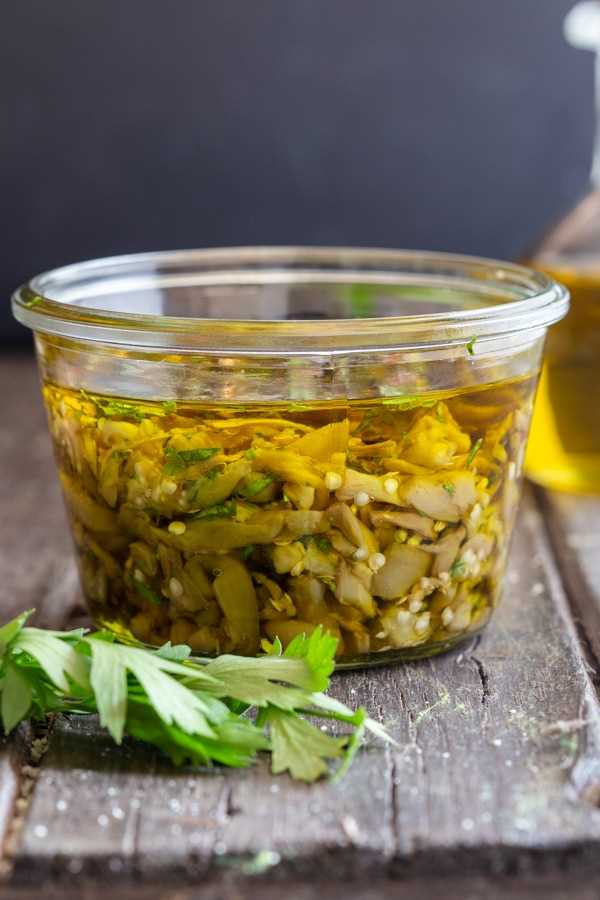
Don’t be afraid to try new varieties and combinations! Pickling is a great opportunity to experiment with flavors and create unique combinations. You may discover new favorites or develop your own signature pickled peppers and aubergines.
| Peppers | Aubergines |
|---|---|
| Bell Peppers | Japanese Eggplant |
| Jalapenos | Italian Eggplant |
| Banana Peppers | |
| Cayenne Peppers |
Preparing the Peppers and Aubergines
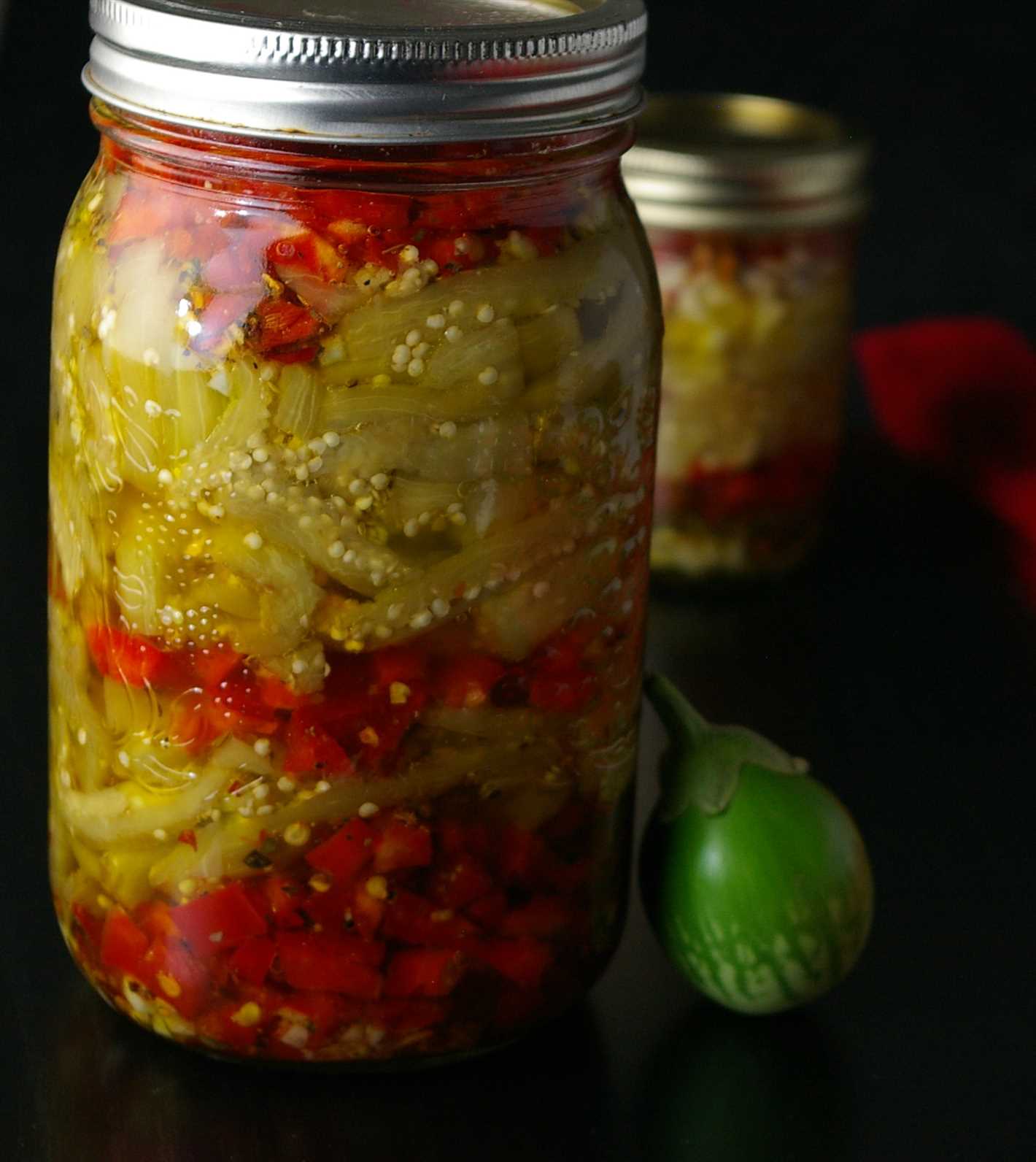
Before you start pickling your peppers and aubergines, it’s important to properly prepare them to ensure the best flavor and texture. Follow these steps to get your vegetables ready for pickling:
Gather the Ingredients
First, gather all the necessary ingredients for pickling, including peppers, aubergines, vinegar, salt, sugar, spices, and any other desired flavorings.
Wash and Dry the Vegetables
Thoroughly wash the peppers and aubergines under cold running water to remove any dirt or debris. Be gentle to avoid damaging the vegetables. Once cleaned, pat them dry with a clean towel or paper towels.
Remove the Stems
Using a sharp knife, carefully cut off the stems of the peppers. For aubergines, remove the green tops. Discard the stems or save them for other recipes.
Cut into Desired Shapes
Decide on the desired shape for your pickled vegetables. Peppers can be cut into slices, rings, or diced. Aubergines can be sliced or cubed. Ensure that all the pieces are uniform in size to ensure even pickling.
Remove Seeds (Optional)
If you prefer less heat in your pickled peppers, you can remove the seeds. Simply slice the peppers in half lengthwise and use a spoon or your fingers to scoop out the seeds and membranes.
Blanch the Vegetables (Optional)
Blanching the vegetables before pickling can help preserve their crispness. Bring a large pot of water to a boil, then place the sliced peppers or aubergines in the boiling water for 1-2 minutes. Remove them from the pot and immediately transfer them to ice-cold water to stop the cooking process. Drain well.
Prepare the Brine
In a large pot, combine vinegar, salt, sugar, and any desired spices. Bring the mixture to a boil, stirring until the salt and sugar dissolve completely. Remove the pot from the heat and let the brine cool to room temperature.
Pack the Peppers and Aubergines
Place the sliced and prepared peppers and aubergines into clean, sterilized jars. Make sure to pack them loosely to allow the brine to penetrate all the vegetables.
Pour the Brine
Once the brine has cooled, carefully pour it over the vegetables in the jars. Make sure that all the vegetables are completely submerged in the brine.
Seal and Store
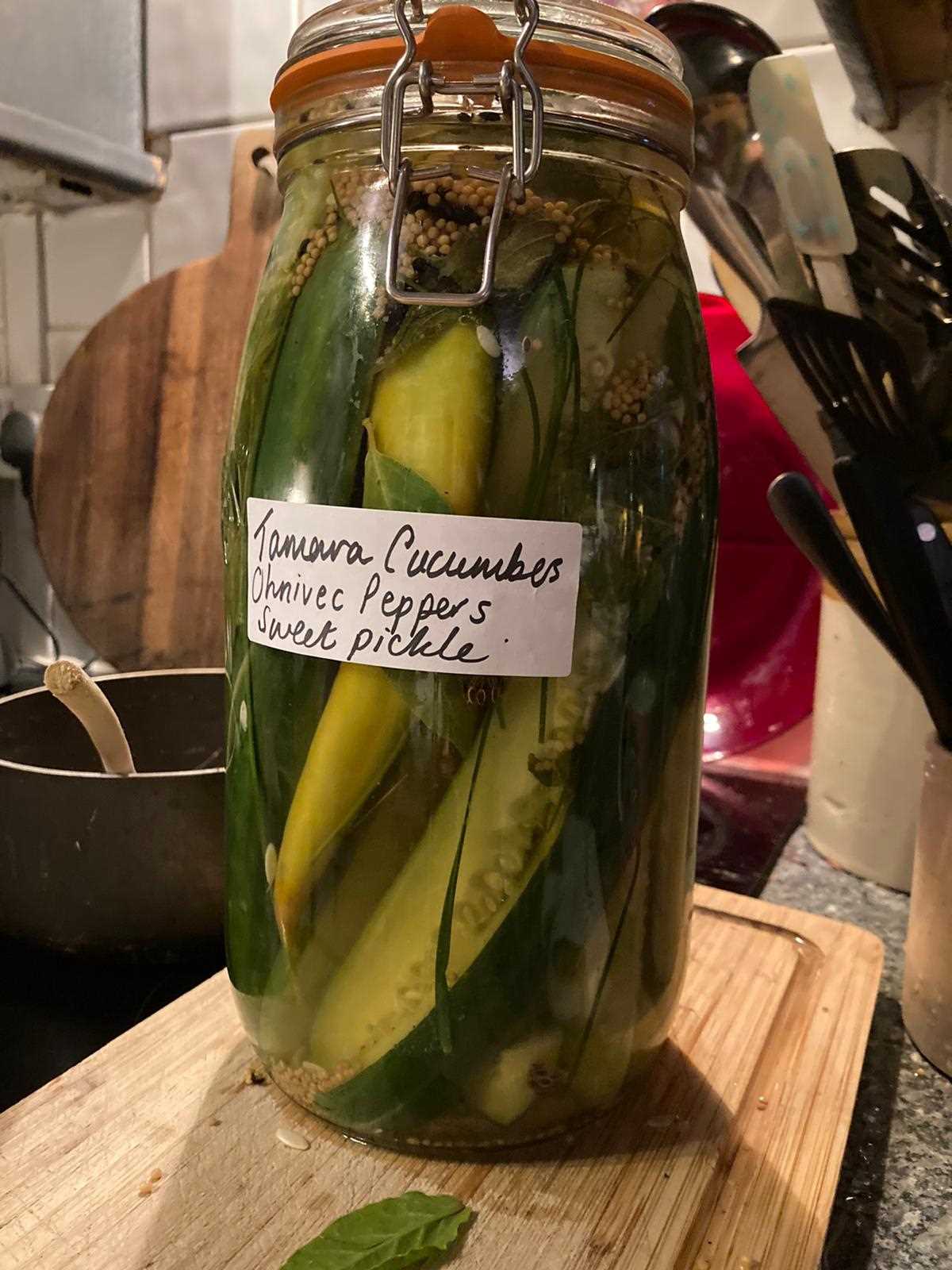
Finally, tightly seal the jars with clean lids. Store them in a cool, dark place for at least a week to allow the flavors to develop. Once you open a jar, keep it refrigerated.
Following these preparation steps will ensure that your pickled peppers and aubergines turn out delicious and flavorful. Enjoy them as a condiment, in sandwiches, or as a tasty addition to your favorite recipes!
Pickling Brine Recipe
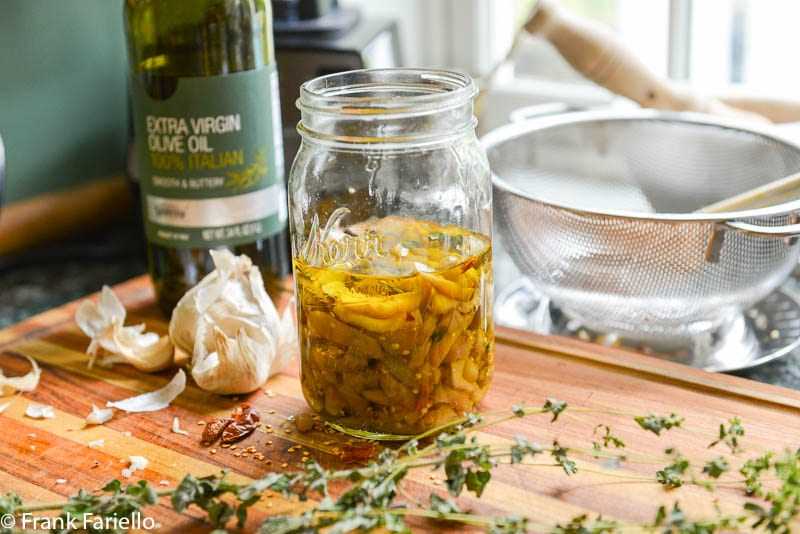
When pickling peppers and aubergines, it’s important to have a good brine recipe. The brine helps preserve the vegetables and gives them that tangy flavor we love.
Ingredients:
- 1 cup water
- 1 cup white vinegar
- 2 tablespoons salt
- 1 tablespoon sugar
- 1 teaspoon black peppercorns
- 1 teaspoon mustard seeds
- 1 teaspoon dill seeds
Instructions:
- In a saucepan, combine the water, vinegar, salt, and sugar. Stir until the salt and sugar have dissolved.
- Add the black peppercorns, mustard seeds, and dill seeds to the saucepan. Stir to combine.
- Place the saucepan over medium heat and bring the mixture to a boil.
- Reduce the heat and let the brine simmer for about 5 minutes to allow the flavors to meld together.
- Remove the saucepan from the heat and let the brine cool to room temperature.
Using the Pickling Brine:
Once the brine has cooled, you can use it to pickle your peppers and aubergines.
- Prepare your peppers and aubergines by washing and slicing them into desired sizes.
- Place the vegetables into clean, sterilized jars.
- Pour the cooled brine over the vegetables, making sure they are completely submerged.
- Seal the jars tightly and store them in a cool, dark place for at least 2 weeks to allow the flavors to develop.
Labeling and Storing:
Remember to label your jars with the date of pickling. Pickles made with this brine recipe can be stored for up to 6 months in a cool, dark place. Once opened, keep them in the refrigerator and consume within a month.
Enjoy Your Homemade Pickles:
Now that you have your pickling brine recipe, you can enjoy homemade pickles all year round! They make a delicious addition to sandwiches, salads, and charcuterie boards.
Brining the Peppers and Aubergines
Brining is an important step in the pickling process as it helps to preserve the vegetables and enhance their flavor. Here’s a detailed instruction on how to brine your peppers and aubergines:
- Start by washing the peppers and aubergines thoroughly under cold running water to remove any dirt or debris.
- Once cleaned, slice the peppers and aubergines into desired shapes and sizes. You can cut them into rings, strips, or cubes depending on your preference.
- Prepare the brine solution by combining water, vinegar, salt, and sugar in a large pot. The ratio of water to vinegar to salt to sugar is usually 3:1:1:1, but you can adjust it according to your taste.
- Bring the brine solution to a boil over medium heat, stirring occasionally to dissolve the salt and sugar.
- Once the brine solution is boiling, add the sliced peppers and aubergines to the pot.
- Cover the pot with a lid and let the vegetables simmer in the brine for about 10-15 minutes, or until they are slightly tender.
- After the desired amount of time, remove the pot from heat and let it cool to room temperature.
- Once cooled, transfer the brined peppers and aubergines along with the brine into sterilized jars.
- Make sure the vegetables are completely submerged in the brine.
- Seal the jars tightly with lids and store them in a cool, dark place for at least a week to allow the flavors to develop.
Brined peppers and aubergines can be enjoyed as a delicious snack, added to salads, sandwiches, or used as a topping for pizza and tacos. They will add a burst of flavor to any dish!
Sealing the Jars
Once you have filled the jars with your pickled peppers and aubergines, it is important to properly seal them to ensure the preservation of your homemade delicacies. Follow these steps to seal the jars effectively:
- Check for cracks or damages: Before sealing the jars, make sure to inspect them for any cracks or damages. Damaged jars may not create a proper seal, leading to bacteria growth and spoilage.
- Remove air bubbles: Use a non-metallic utensil, such as a wooden spoon or a plastic spatula, to remove any air bubbles that may have formed in the jar. This step helps to prevent uneven preservation.
- Wipe the jar rim: Take a clean, damp cloth or paper towel and carefully wipe the rim of each jar. Make sure there is no food residue or liquid on the rim, as this can interfere with the sealing process.
- Apply the lid: Place a clean lid on top of each jar. Gently press down on the lid until it sits snugly on the rim.
- Screw on the band: Take a band and twist it onto the jar, securing the lid in place. Do not overtighten the band, as this may prevent the jars from properly sealing.
- Water bath canning: If you want to further ensure the sealing of the jars, you can use the water bath canning method. Place the sealed jars in a large pot filled with boiling water, making sure there is at least an inch of water covering the jars. Allow the jars to boil for a specified amount of time, as recommended by the recipe or canning guidelines.
- Cool and test the seal: Once the jars have been processed, remove them from the water bath and allow them to cool. As they cool, you will hear a “pop” sound, indicating that the jars have sealed properly. To test the seal, press down on the center of each lid. If it is firm and does not move, the seal is secure. If the lid moves or makes a clicking sound, the jar did not seal and should be refrigerated or reprocessed using a new lid.
Following these steps will ensure that your pickled peppers and aubergines stay fresh and delicious for a long time. Enjoy the fruits of your labor and share them with friends and family!
Storing and Maturing
Once you have picked your peppers and aubergines, it’s important to store them properly to ensure they mature and develop their full flavor. Here are some tips on how to store and mature your picked vegetables:
Adequate Drying
Before storing your peppers and aubergines, make sure they are fully dry. Wipe off any excess moisture with a clean cloth, as moisture can lead to spoilage.
Optimal Temperature
Store your peppers and aubergines in a cool, dry place. A temperature of around 50°F (10°C) is ideal for slow and proper maturation.
Avoid Direct Sunlight
Direct sunlight can cause your vegetables to ripen too quickly and may result in uneven maturation. Find a dark spot to store them away from sunlight.
Air Circulation
Ensure that there is enough air circulation around your stored peppers and aubergines. This will help prevent mold or rot from developing.
Avoid Storing with Fruits
Do not store your peppers and aubergines together with fruits, as fruits release ethylene gas that can speed up the ripening process and affect the flavor of your vegetables.
Check Regularly
Check on your stored vegetables regularly to remove any that show signs of spoiling. This will help maintain the quality of the remaining peppers and aubergines.
Extended Storage
If you want to store your peppers and aubergines for an extended period, consider freezing or pickling them. Freezing will preserve their flavor, while pickling will enhance their taste and create a tangy addition to your meals.
By following these tips, you can ensure that your picked peppers and aubergines mature and develop their full flavor, so you can enjoy them for an extended period.
Using Pickled Peppers and Aubergines
Pickled peppers and aubergines can add a burst of flavor to a variety of dishes. Here are some ideas for using these tangy vegetables:
1. Antipasto Platter
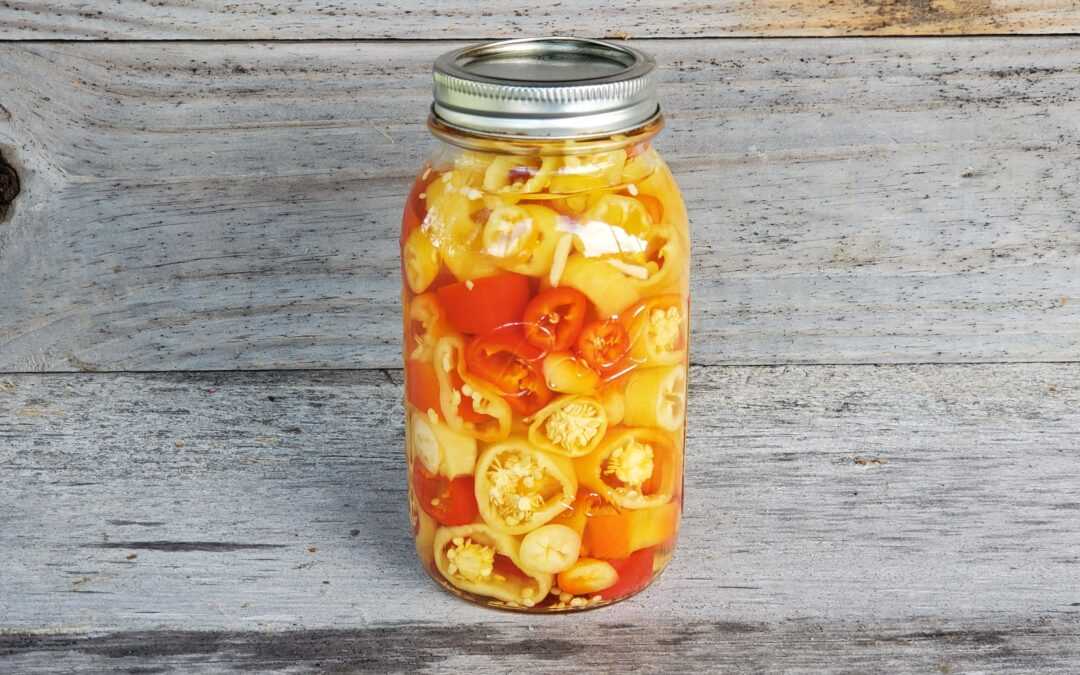
Create a colorful antipasto platter by arranging slices of pickled peppers and aubergines alongside cured meats, cheese, olives, and bread. Serve as an appetizer or as part of a larger spread.
2. Sandwiches and Wraps
Add a zesty kick to your sandwiches and wraps by layering in some pickled peppers and aubergines. The tangy flavor will complement the other ingredients and provide an extra dimension of taste.
3. Salads
Toss pickled peppers and aubergines into your favorite salads for a burst of flavor. They work particularly well in Mediterranean-inspired salads with feta cheese, olives, and tomatoes.
4. Pizza Toppings
Sprinkle slices of pickled peppers and aubergines on top of your homemade or store-bought pizza for a tangy twist. The acidity of the pickled vegetables will cut through the richness of the cheese and add a burst of flavor.
5. Pasta Sauce
Chop up pickled peppers and aubergines and stir them into your favorite pasta sauce for an added kick. The tanginess will balance out the sweetness of the tomatoes and add a depth of flavor to your dish.
6. Tacos and Quesadillas
Enhance your tacos and quesadillas by adding a spoonful of pickled peppers and aubergines. The tangy flavor will complement the other ingredients and provide a refreshing contrast to the richness of the fillings.
7. Charcuterie Boards
Incorporate pickled peppers and aubergines into your charcuterie boards as vibrant and flavorful additions. They will add a tangy element to the cured meats, cheeses, and other accompaniments.
8. Mezze Platters
For a Mediterranean-inspired feast, include pickled peppers and aubergines on your mezze platters. These tangy vegetables pair well with hummus, tzatziki, pita bread, and other Middle Eastern and Mediterranean dips and appetizers.
With their tangy flavor and versatile uses, pickled peppers and aubergines are a delicious addition to any meal. Experiment with different combinations and dishes to discover your favorite way to enjoy these flavorsome vegetables.
Troubleshooting and Tips
1. Overripe Peppers and Aubergines
If your peppers or aubergines are overripe, they may become soft and lose their crunch when pickled. To avoid this, always pick your vegetables when they are firm and fully ripe.
Tips:
- Inspect your plants regularly and harvest the peppers and aubergines once they reach the optimal ripeness.
- Avoid leaving the vegetables on the plant for too long as they will continue to ripen, becoming overripe and less suitable for pickling.
2. Bitter Taste
If your pickled peppers or aubergines have a bitter taste, this can be due to a few factors.
Tips:
- Make sure you remove all the seeds and pith from the peppers and aubergines before pickling. These parts can contribute to a bitter taste.
- Ensure that you use the correct ratio of vinegar to water in your pickling solution. Too much vinegar can result in a bitter flavor.
- Consider adding a small amount of sugar or honey to balance the flavors and reduce bitterness.
3. Mold Growth
If mold starts to grow on the surface of your pickled peppers or aubergines, it’s important to discard the entire batch as it can be harmful if consumed.
Tips:
- Always use clean and sterilized jars to minimize the risk of mold growth.
- Ensure that your pickling solution is hot when pouring it over the vegetables to create a proper seal and kill any potential mold spores.
- Store your pickled vegetables in a cool, dark place to prevent mold growth.
4. Weeping Vegetables
If your pickled peppers or aubergines release excess liquid and become watery, it can be a result of various factors.
Tips:
- Avoid overcooking the vegetables before pickling, as this can lead to a loss of texture and excess moisture.
- Use fresh and firm peppers and aubergines. Older vegetables tend to release more liquid during pickling.
- Ensure that you pack the vegetables tightly in the jars and leave enough headspace to allow for expansion during the pickling process.
5. Inconsistent Flavor
If your pickled peppers or aubergines have an inconsistent flavor, it could be due to variations in the ripeness or quality of the vegetables.
Tips:
- Try to use vegetables of similar size and ripeness to ensure a more consistent flavor.
- Adjust the pickling solution by adding more spices or vinegar to enhance the flavor of the vegetables.
- Give the pickled vegetables enough time to mature and develop their flavor before consuming.
These troubleshooting tips and suggestions will help you overcome common challenges when pickling peppers and aubergines. Experiment with different variations and techniques to find the perfect pickling method that suits your taste.
“Question-Answer”
What are some common types of peppers and aubergines that can be pickled?
Some common types of peppers that can be pickled include jalapeno, banana pepper, and bell pepper. As for aubergines, varieties such as Black Beauty and Rosa Bianca are often used for pickling.
What are the basic ingredients needed for pickling peppers and aubergines?
The basic ingredients needed for pickling peppers and aubergines include vinegar, water, salt, sugar, and various spices such as garlic, dill, and mustard seeds. These ingredients are used to create a brine that will preserve and flavor the vegetables.
How do you prepare the peppers and aubergines before pickling?
Before pickling, it’s important to wash the peppers and aubergines thoroughly. Then, the peppers should be sliced, removing the seeds if desired, while the aubergines can be sliced or cubed. Some recipes may recommend salting and draining the aubergines to remove any bitterness.
How long does the pickling process take?
The pickling process typically takes around 1 to 2 weeks. After preparing the brine and pouring it over the peppers and aubergines in jars, they should be left to sit at room temperature for about a week to ferment. Then, they can be moved to the refrigerator where they will continue to pickle for another week or so.
Can you adjust the level of spiciness in pickled peppers?
Yes, you can adjust the level of spiciness in pickled peppers by controlling the type and amount of peppers you use, as well as the amount of spicy spices such as chili flakes or hot sauce. If you prefer milder pickled peppers, you can choose mild pepper varieties and reduce the amount of spicy ingredients.
Can pickled peppers and aubergines be stored for a long period of time?
Yes, pickled peppers and aubergines can be stored for a long period of time, typically up to a year. As long as they are properly sealed in jars and stored in a cool, dark place, they should remain safe to eat and retain their flavor for an extended period.
What are some recipe ideas for using pickled peppers and aubergines?
There are many recipe ideas for using pickled peppers and aubergines. Some popular options include adding them to sandwiches or burgers, using them as a topping for pizzas or salads, incorporating them into pasta dishes or stir-fries, or simply enjoying them as a flavorful and tangy condiment.







